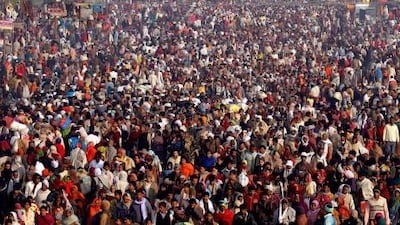As the UN officially marks the arrival of the planet's 7 billionth person today, the UAE is already braced to confront the challenges of the future.
With one of the world's most rapidly growing populations, the country is pushing to find solutions to strains that will be placed on supplies of power, food and water, and resources around the world.
And while the number of UAE residents is ballooning, fewer children are being born here and the fertility rate for Emiratis is dropping, in line with global trends.
The UN Population Fund says there are now twice as many people sharing the world's resources as there were in the 1960s. It expects the global population to pass 9 billion in the next 40 years.
Local researchers are looking for answers to the country's own resource problems, including its reliance on power to desalinate water and exposure to world food shortages, as the UAE imports 85 per cent of its food needs.
Experts are studying rainfall harvesting, freshwater storage in underground aquifers and the re-use of waste water for agriculture, as well as integrating renewable energy into the desalination process.
They say their research will set standards for other countries that are vulnerable to limited resources.
While the number of people on Earth has doubled in the past half century, the rate at which it is growing has slowed.
The population rose by almost 2 per cent a year in 1960, but the current rate is half of that.
In the UAE, the average number of births for each woman has dropped from 4.4 in 1990 to only 1.9 in 2009, the most recent statistics from the World Health Organization show.
The Health Authority - Abu Dhabi attributes this to delayed marriage, changing attitudes about family size and more education and work opportunities for women.
About a fifth of the world lives in countries with high fertility rates, with sub-Saharan Africa accounting for about half of the expected 2.1 billion increase in the world's population over the next 40 years.
Areas with the highest birth rates tend to see the deepest poverty and greatest strain on resources.
By 2030, more than a third of the population in many western and Asian countries are expected to be aged over 65, with fewer people to care for them.
In China, which has the world's largest population - 1.34 billion people - a one-child policy instated 30 years ago has led to what has been called a "demographic time bomb", with only two workers for each person over 60 years old. A decade ago, the ratio was six to one.
The country, which also faces a growing gender imbalance, is expected to lose its spot as the world's most populous nation to India, which has had population growth of 17 per cent over the past decade to hit 1.21 billion last year.
An estimated 50 Indian babies are born every minute, but they have a 50 per cent chance of being malnourished during their infancy and a 5 per cent chance of dying before their fifth birthday.
* With additional reporting by Martin Croucher, Daniel Bardsley and Eric Randolph

